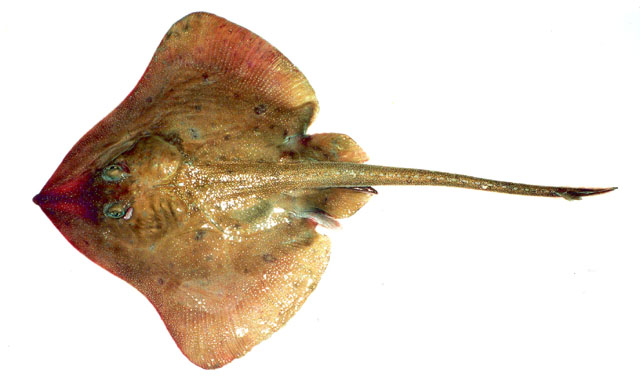| Arhynchobatidae (Softnose skates) |
| 89 cm TL (male/unsexed) |
|
bathydemersal; marine; depth range 23 - 1500 m |
| North Pacific: Bering Sea, Alaska south to British Columbia, Canada. |
|
This moderately-sized skates (82.5 cm TL) with disc length (47.7-54.0% TL) are distinguished by the following; head length moderate (18.4-21.4% TL), posterior lobe of pelvic fins are long (10.4-23.4% TL); claspers are long and robust, tip rounded and not bulbous, no pseudosiphon, with a weak, but long pseudorhipidion, U-shaped cleft, projection rounded and protrudes from tip, has a very large sentina, sentinel present; teeth in 22-32 rows on upper jaw, teeth in 23-32 rows on lower jaw; total vertebrae 133; dorsal surface covered in small, sandpaper-like prickles; thorns in a non-continuous row, mature males with strong alar thorns, no malar thorns, middorsal thorns strong (1-8), nuchal thorns robust (2-5), tail thorns moderate (18-26), interdorsal thorns weak (0-1). Colouration: dorsal brown to grey, with numerous small dark spots on body; ventral white, often with dark brown blotches on underside of tail (Ref. 126515). |
| Inhabit the outer continental shelf, on mud or sand bottoms (Ref. 27436). Frequently found buried in substrate (Ref. 27436). Feed on benthic invertebrates including euphausiids, crabs, and various shrimps (e.g., pandalids, hippolytids, crangonids) and bony fishes. Reported size at maturity for males is 69-70 cm TL and for females 71-72 cm TL, with a maximum size of at least 89 cm TL (Ref. 126515). Oviparous. Distinct pairing with embrace. Young may tend to follow large objects, such as their mother (Ref. 205). Eggs are deposited in sandy or muddy flats (Ref. 205). Egg cases are small (7.8-7.9 cm TL), colour golden brown, covered with small and coarse prickles that form longitudinal rows. The egg cases with lateral keels very wide, horns taper and become thin and filamentous at their ends, with the anterior horn being more robust (Ref. 126515). Although the pectoral fins may be used to prepare a variety of dishes, they are generally considered not saleable, and incidental catches are usually discarded (Ref. 27436). Occasionally used to produce mink feed and fertilizer (Ref. 27436). Minimum depth reported from Ref. 6793. |
|
Least Concern (LC); Date assessed: 15 October 2015 Ref. (130435)
|
| harmless |
Source and more info: www.fishbase.org. For personal, classroom, and other internal use only. Not for publication.

